SATURDAY
DECEMBER 30 - 2017
Avocets
at Nutbourne
Chris
Berners-Price put his Christmas present of a Panasonic
Lumix camera TZ70 to good use to get some nice shots
of a flock of Avocets at Nutbourne. I counted 33 birds
on Chris's photo of the Avocets on the sea.
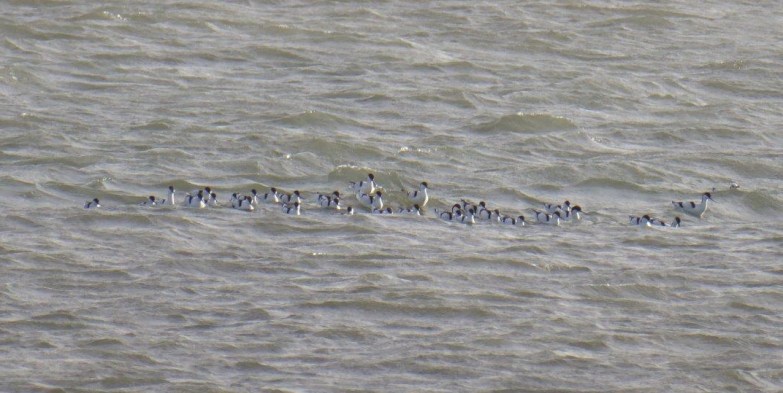
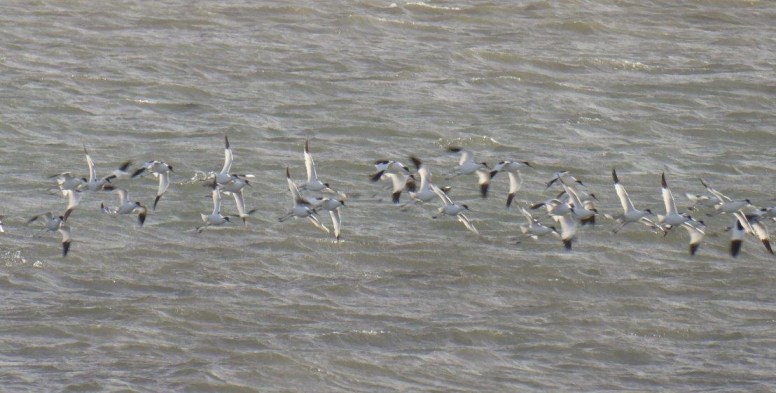
THURSDAY
DECEMBER 28 - 2017
Millpond
walk
Jean and I had
a walk around the town millpond this morning and just
past the bridge along Bath Road, we were chatting to a
friend when a Grey Wagtail, showing its
beautiful yellow underparts and wagging its tail
madly, landed almost at our feet. It only remained for
a few seconds, but a lovely way to start our walk.
Grey Wagtail (not to be confused with Yellow Wagtail
which is a rare summer visitor) is a fairly common
bird around the waterways in Emsworth, but I do not
recall having seen one quite this close in the middle
of a road before! However, I often see one along the
Westbrook Stream which runs into the millpond and here
is a photo I got of one on this stream a few years
ago.
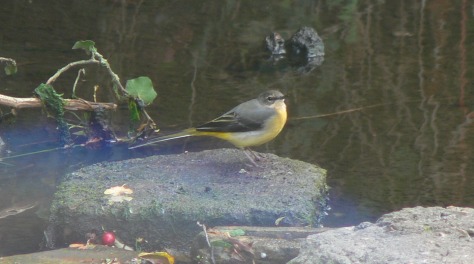
The pond itself was
partly frozen over with a group of Black-headed
Gulls standing on the ice. How is it that gulls
seem to favour standing on the ice rather than
swimming around in the water like the Mallard and
Coot?
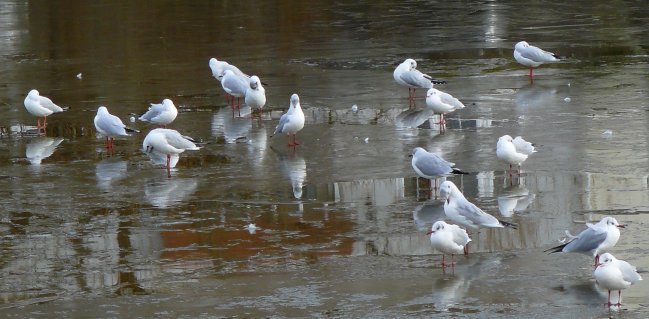
Our walk ended with
another fine sighting, but at the opposite end of the
avian spectrum to the Grey Wagtail. Soaring over the
Slipper Mill Sailing Club building was a
Buzzard with mottled brown underwings. It was
good to see several other people had spotted the bird
and were gazing skywards in rapt admiration. The
Buzzard did not stay long as it was chased off its
territory by a Carrion Crow. Here is a photo that Tony
Wootton got a few years ago of a Buzzard being chased
by a Carrion Crow.

Warblington
shore
Peter
Milinets-Raby walked along the Warblington area today
at virtually the same time as yesterday (11:08am to
1pm - tide out). And what a difference a day and a
chilly wind make!? Mainly concentrated on the fields
just north of Conigar Point, details as follows:
49 Skylark flock - nice to have lots after several
winters with barely double figures. 11 Meadow Pipit, 2
Pied Wagtails - (note on Pied Wagtail photo - Easily
mistaken for a White Wagtail, but, dark smudge along
the rear of the flank to the side of rump is
diagnostic, plus black crown, pale grey in White
Wagtail first winter).
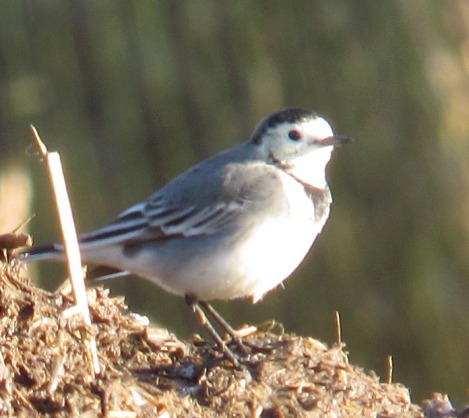
1 Grey Wagtail, 3 Song
Thrush, 10 Stock Doves, Conigar Point: 30 Shelduck, 1
Grey Plover,
Off Pook Lane: 77 Shelduck, 2 Turnstone, Pair of
Goldeneye. Pair of Pintail, 57 Teal.
Warblington church/field to the west: 8 Little Egrets,
11 Redwing, 3 Curlew.
Later in the day (3pm) we had a family walk around the
half frozen Emsworth Mill pond:
Had the Kingfisher in fight on three occasions (great
photo the other day of this bird - so close!!)
41 Coot and a Little Grebe swam the entire unfrozen
length all the way down to the main road, before
returning back.
Two
Red Kites
While out on a
bike ride this afternoon Geoff Gilbert was pleased to
have excellent views of two Red Kites circling low
over and between trees on the ridge, to the east side
of the road. Geoff did not get a photo, but here is
one of two Red Kites that Colin Vanner got at Arundel
a few years ago.
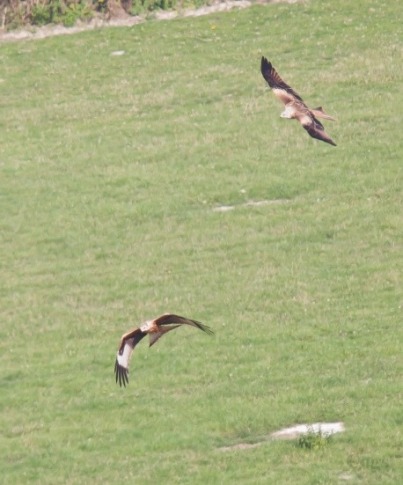
WEDNESDAY
DECEMBER 26 - 2017
Warblington
shore
Peter
Milinets-Raby had a walk around the Warblington shore
after the snow early snow had melted between 11:15am
and 1:20pm. Here is his report . . .
Field to the west of the cemetery: 13 Oystercatcher, 1
Redshank - unusual off the shore, 2 Common Gull, 12
Little Egret.

In the field south of
the cemetery: 41 Redwing, with 5 Fieldfare and 3 Song
Thrush.
Off shore at Pook Lane - low tide: 398 Dunlin, 290
Brent Geese, 19 Wigeon, Female Goosander feeding in
the channel, loosely associating with 16 Red Breasted
Merganser. 1 Great crested Grebe, 55 Shelduck, 1
Greenshank, 13 Grey Plover, 4 Black-tailed Godwit, 2
Sandwich Tern resting on the mud, 2 Teal, 4 Pintail (2
pairs),
In the distance off Conigar Point were: 6 Red breasted
Merganser, 20 Grey Plover, 123 Dunlin, 6 Shelduck, 65+
Wigeon.
TUESDAY
DECEMBER 26 - 2017
Millpond
Kingfisher
Kingfishers
are often seen flying low across the millponds in
Emsworth during winter, but they don't often perch
long enough to give one the opportunity to see their
beautiful plumage. However, Keith Wileman was in luck
when he walked round the town millpond today when
someone pointed out a Kingfisher that was perched in a
tree at the southern end of the pond near the sluice
gate. It was far enough away not to be disturbed by
the crowds of people out walking, but not too far for
Keith's super zoom camera and it just sat there while
Keith took dozens of photos. Keith chose the following
one to send to me and what a cracker it is, clearly
showing its lower red mandible indicating it is a
female. The male's mandibles are both black.
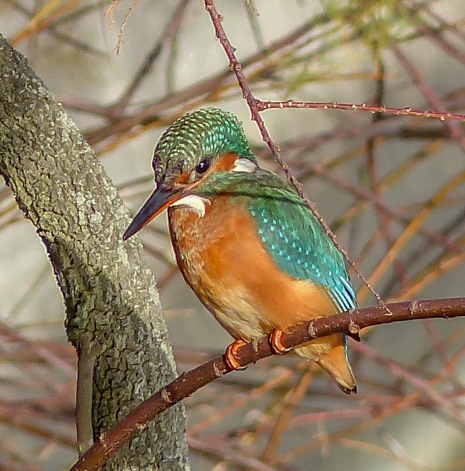
SUNDAY
DECEMBER 24 - 2017
Christmas
Eve walk
Jean and I had
an interesting walk around the local area on a mild
and slightly drizzly morning. While walking along
Bridgefoot Path I spotted my first Tufted Duck
of the year on the town millpond, a single male. Here
it is with a Coot.

Tufted Duck used to be
a regular winter visitor on the millpond with a
maximum of 74 in Jan 2001. However, numbers have
slumped in recent years, probably due to the warmer
winters. I do not recall seeing any at all last year.
Let's today's sighting is a sign and that we shall
again be able to enjoy these cute diving birds.
We stopped at
Flintstone's cafe where (as it was Christmas) I
indulged in a glass mulled wine and a mince pie with
cream. It was heavenly! PS: Jean stuck to coffee. I
asked the waitress to take a photo of us! A happy
Christmas to you all!
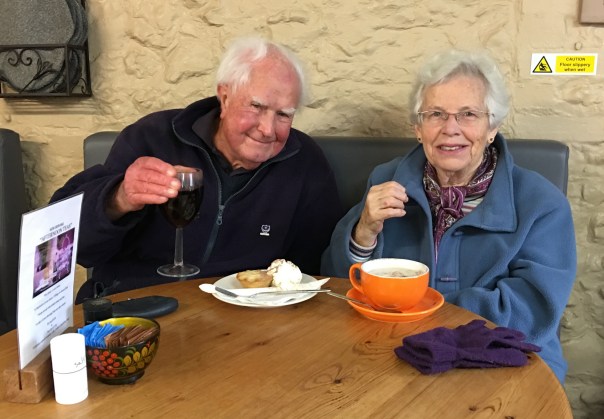
We had a quick look at
the harbour where the pair of Black Swans were
present and still being closely attended to by the cob
Mute Swan. The rest of the family with the 5 cygnets
were in the channel near the quay.

This afternoon the two
Black Swans had moved onto the town millpond where
they were seen by Barry and Margaret Collins.
Despite the drizzle we
decided to return home via Brook Meadow where we had a
couple of interesting meetings. First we met a couple
of chaps who had just had a close encounter with a
Roe Deer on the meadow. It came through the
tunnel under the railway and raced past them at great
speed! I explained that Roe Deer do sometimes move
through the meadow, though they are rarely seen at
such close quarters. My only other reported sighting
of Roe on the meadow this year was by Mark Ringwood on
Jan 7. Here is a nice photo that Romney Turner got of
three Roe Deer in the fields at Lumley north of Brook
Meadow a few years ago.
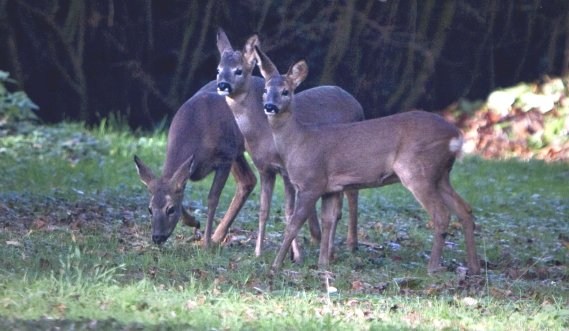
Finally, we noticed a
party of people having drinks at Frank's seat
on the west side of the north meadow. I called out to
them and they explained they were members of Frank
Style's family who had donated the seat so I asked
them for a photo. Frank was a volunteer on Brook
Meadow and sadly passed away earlier in the year.
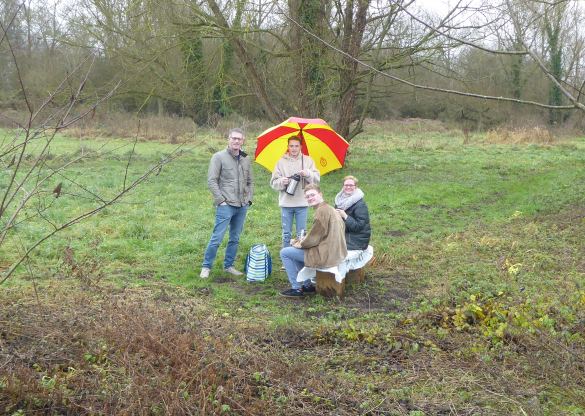
BTO
Bird Trends report
The BTO Bird
Trends report which has only just been published
confirms the rapid decline of the familiar Greenfinch
(down by 59% in just ten years) as a result of the
disease trichomonosis. See . . . https://www.bto.org/about-birds/birdtrends/2017
Although the European
population is said to be stable, Keith Betton tells me
that the disease has recently spread over there too.
The disease is possibly carried by our Chaffinches,
some of which are Scandinavian breeders. The
Greenfinch graph on the following website, shows a
gentle decline in Europe since 2010 which might be the
start of the problem there too. See . . .
http://www.ebcc.info/index.php?ID=612
Greenfinch used to be
my number one garden bird, with over 20 sometimes
coming to the feeders. Now, I rarely see one, or two
at the most, and then not regularly. Here is a shot of
7 Greenfinches on my garden feeders before the serious
decline set in.

SATURDAY
DECEMBER 23 - 2017
Avocets
at Nutbourne
Anne de Potier
reported that the Avocets are back at Nutbourne.
Yesterday, she saw about 35 in the distance, flying
towards Thorney. Up to 40 Avocets are regular winter
visitors to Nutbourne Bay. Here is a similar number of
Avocets in flight to what Anne saw, taken by Romney
Turner at Nutbourne a few years ago.
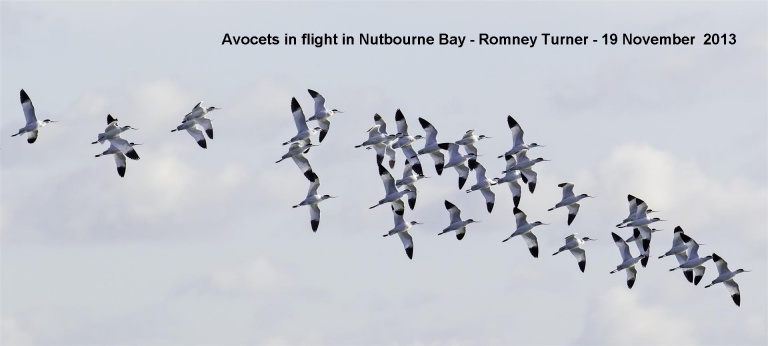
Little
Owl at Racton
Yesterday (Dec
22) Caroline French saw a Little Owl in the old Oaks
on Racton Park Farm while carrying out the Sussex
Winter Bird Survey on the BBS square SU7808. I always
looked for Little Owl when I used to do the Breeding
Birds Survey in this same square, but rarely (if ever)
saw one. They are very hard to spot, so well done
Caroline. Here is her photo, showing the distintive
eye.
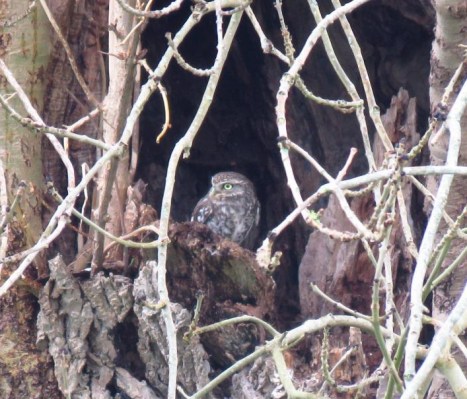
THURSDAY
DECEMBER 21 - 2017
Xmas
work session
I went over to
Brook Meadow this morning for the special Xmas work
session. There was an excellent attendance of
volunteers. Here is the group, including me for a
change!

The main task was to
continue to clear the river and its banks of excess
vegetation and overhanging branches.
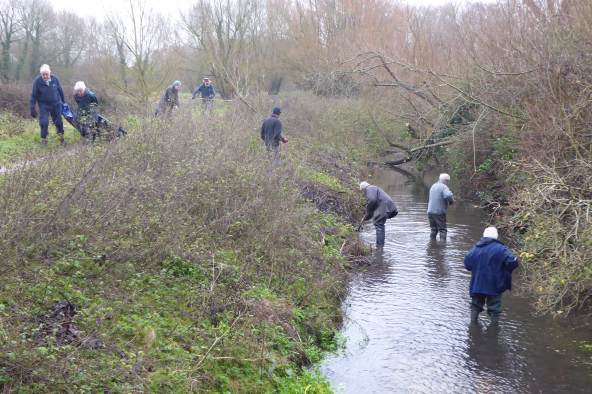
Meanwhile, a bonfire
was made of the smaller twigs and branches.
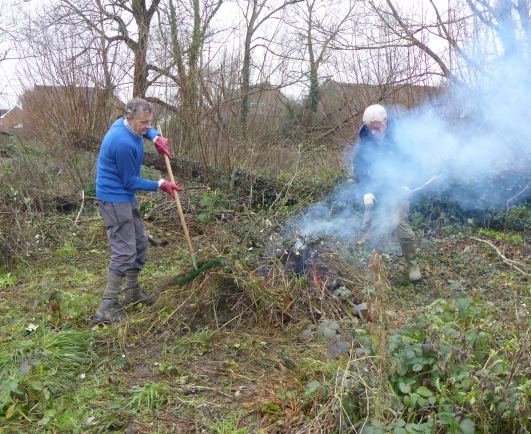
The aim of this work
is to improve the river habitat for Water Voles, fish
and other wildlife and to generally enhance its
appearance, which has gone down seriously over the
past 10 years. Here is the group with the fruits of
their work. An excellent start, but there is much more
to do.
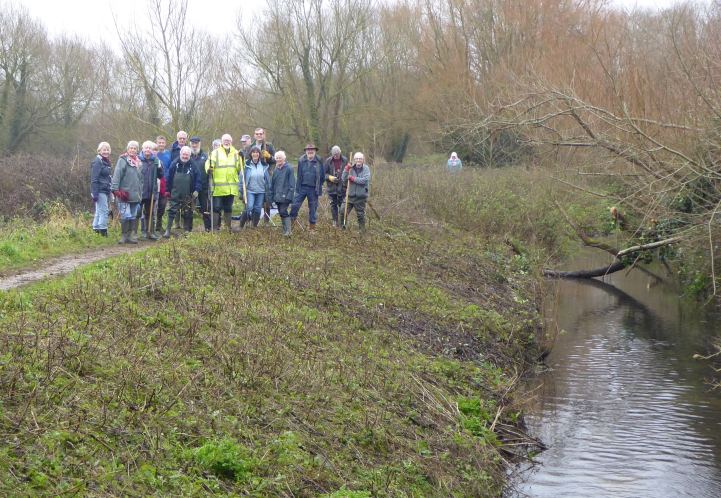
I took photos of the
work and wandered around looking for any interesting
wildlife. On the bird front a Song Thrush was singing
strongly in the north-east corner of the north meadow
and another on the west bank near the factories. I
noted Hogweed and Gorse as the two main flowers.
At the end of the work
session we all assembled at the tool store for the
annual festive celebration with mulled wine and mince
pies and stollen. Excellent it was too!
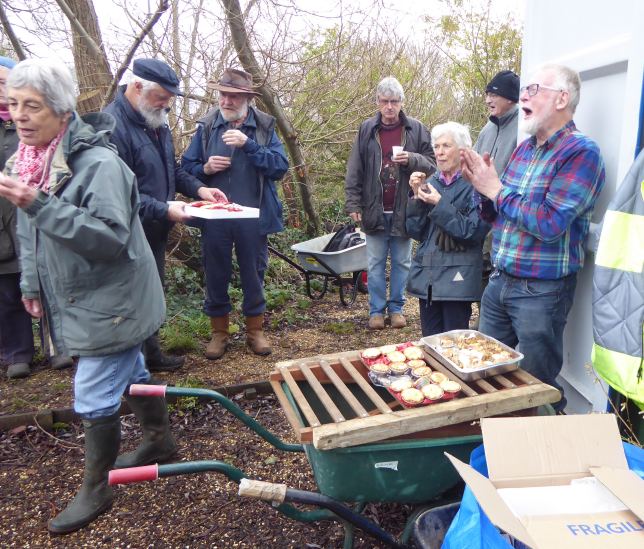
A full report of the
work session with more photos is on the Brook Meadow
web site
Go to . . . https://www.brookmeadow.org.uk/conservation-news/
Black
Swans
I had a walk
down to Slipper Millpond where I found two Black Swans
being chased by the resident pair of Mute Swans. There
was no sign of the cygnets which I assume have been
dispatched with the breeding season looming.

Dog
disturbance at Nore Barn
This morning
(between 11:20am to Noon) as the tide was pushing in
Peter Milinets-Raby was enjoying a very pleasant walk
along the foreshore and footpath of Nore Barn.
However, his enjoyment was cut short by an unfortunate
encounter with a particularly boisterous dog. His
(slightly edited) report follows . . .
I had
stopped by the stream and was resting my camera on the
telescope on my tripod and was happily taking photos
of the obliging Greenshank in the stream, when an
unleashed dog decided to bound over and gatecrash my
outing.
Such was this hairy beast's enthusiasm to join me, he
hurtled at my tripod like a bowling ball into a line
of skittles, and in the process nearly knocked me and
my tripod off our feet. The hound clearly couldn't
understand the fuss as I grabbed my teetering tripod
and tried to soothe the optics fears of crashing to
the floor and shattering into a million pieces. But
worse still, neither could its owner.
Indeed, instead of inquiring if any harm had been
done, the owner threw the mongrel a smile of
absolution and excused the excitable hound's behaviour
as youthful exuberance!! Then, with breath-taking
indifference to my very expensive telescope
(£1,300) the owner assured me that his thumping
great pet "didn't mean any harm". And with that the
owner blew his dog whistle, swung the animal's
redundant lead over his shoulder and walked off. The
dog didn't heed the whistle and dived into the water
to chase a couple of Mute Swans and consequently
disturbed everything in the stream - the Greenshank
flying off over the hill and far far away. The owner
then shouted very loudly, blew his whistle several
times and of course the dog totally ignored him and
dashed off at break-neck speed along the Nore Barn
footpath to gate-crash the next poor un-expecting
soul!
When
all was peaceful the birds at Nore Barn were as
follows: 332 Wigeon (Superb count and ironically a
wonderful sight when they were all flushed!!), 28
Black-tailed Godwit, 57 Teal, 321 Brent Geese, 1
Greenshank usual colour ringed - see photo, 1
Shelduck, 2 Great Crested Grebes.
Brian's Note on
Peter's experience
I have been birdwatching at Nore Barn for many years
and have also had encounters with dogs, but none has
been as bad as Peter's. I do hope it does not put him
off visiting the site as his careful observations and
recordings have made such an important contribution to
our knowledge of the wildlife of this area.
Like Peter, I get annoyed when dogs chase birds in the
harbour and I try to speak to the owner (if I have the
courage) to point out the importance of not disturbing
these birds which have flown thousands of miles to be
with us and which so enrich our environment.
Generally, the response is reasonable and
understanding, though they often make the point that
the site is also a valuable recreational area for the
exercise of dogs which many people get great pleasure
from - and this has to be admitted. We all have to
live together on this one small planet! I truly
believe that education is the best solution, though it
is a long term solution.
Generally speaking, I don't think dogs do a great deal
of damage to the birds at Nore Barn, apart from
killing the occasional swan. I have never seen any
smaller birds, geese, ducks or waders caught by a dog.
The Spotted Redshank, for example, which has been
coming here for the past 14 years, is unfazed by the
dogs running in and out of the stream. It is possible
that birdwatchers are more disturbed by dogs than are
the birds!
WEDNESDAY
DECEMBER 20 - 2017
Nore
Barn
The tide was
already well advanced by the time I got to Nore Barn
at 11am with the stream filling up fast. I was
probably a bit too late for the regular Spotted
Redshank and the Greenshank, though a Common Redshank
and a Black-tailed Godwit were hanging on. Here is the
Godwit.
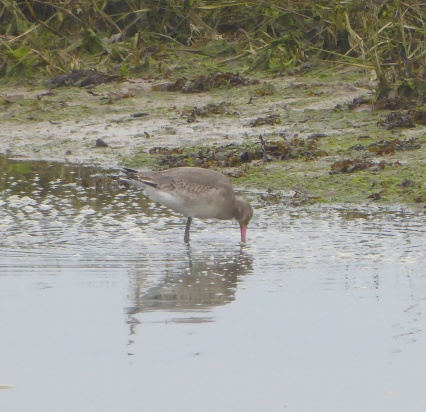
There were plenty of
Brent Geese in the creek along with a scattering of
Wigeon and Teal but nothing else of special interest.
Guillemot
Kate L'Amie
saw a Guillemot yesterday sailing through the gap into
Langstone Harbour - viewed from next to the Hayling
Ferry pontoon, on the Eastney side. It was having a
good old preen as it proceeded into the harbour then
disappeared out of view up to the north-east. This
could be the same bird that was photographed by Tony
Wootton in the sea off Hayling on Dec 18 (see
below).
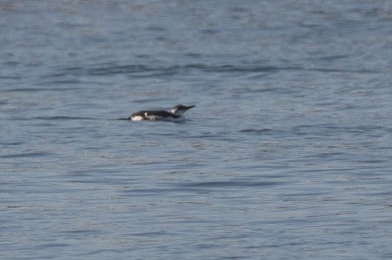
Warblington
shore
Peter
Milinets-Raby visited the Warblington shore this
afternoon. High tide, but slowly dropping 1:25pm to
2:55pm. His report follows:
Warblington cemetery: 2 Mistle Thrush, 1 Redwing.
Fields around farm (Lots of disturbance with tractor
cutting/hacking hedges by black barn). 5 very flighty
Little Egret.
Ibis Field: 5 Redwing, 1 Mistle Thrush, 2 Song
Thrush.
Big field to east by rotting wheat stems: 35 Curlew, 3
Meadow Pipit, 2 Pied Wagtail, 1 Buzzard, Skylark
heard, Green Sandpiper heard in distance by cress
beds, 5 Linnet, Male Reed Bunting in hedge.
Conigar Point: 3 male and 10 female Pintail, 97
Wigeon, 4 Teal, 44 Shelduck, 117 Brent Geese - some
nice and close on the high tide see photo - great
little birds, a shame they are facing extinction!!
(Peter's little joke). 6 Brent in the field south of
the cemetery
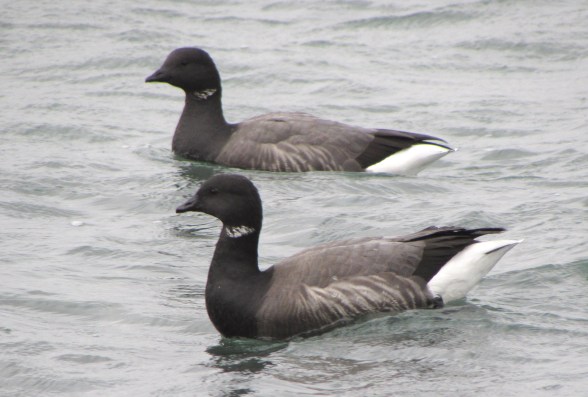
Off Pook Lane: 10 Red
breasted Merganser, 1 female Goldeneye, 42 Shelduck,
55 Wigeon, 2 Teal, 2 Great Crested Grebe.
TUESDAY
DECEMBER 19 - 2017
Emsworth
walk
The light mist
created a magical atmosphere for this morning's walk
through Brook Meadow.
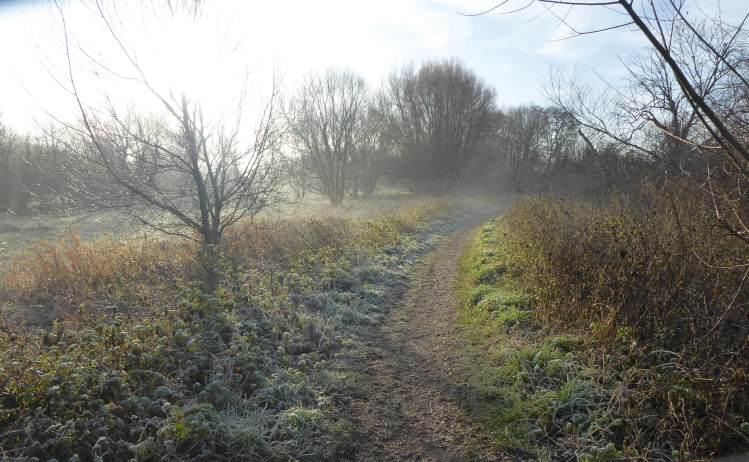
Looking back, the hard
overnight frost was taking time to clear from the
nettle leaves along the main river path.
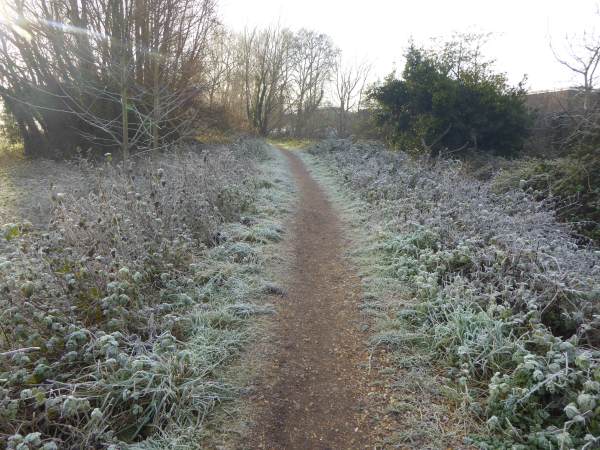
Many fresh
molehills were coming up along the paths through
the main meadow as these small subterranean creatures
dig new tunnels in their hunt for worms. I actually
watched this one in the photo being created, as the
Mole (never showing itself) pushed soil up from below.
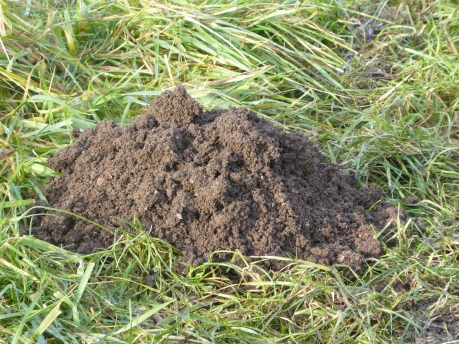
Down to Peter Pond,
where a few bright yellow flowers of Hoary
Ragwort were making the most of the winter
sunshine, smiling serenely at the busy Christmas
traffic, hurtling past merely yards away.

Meanwhile, across the
road to Slipper Millpond, I had a truly festive sight
of seven swans a-swimming in Dolphin Lake
almost prompting me into song. They are the regular
Mute Swan family from the Peter Pond nest still with 5
cygnets intact, though one youngster was lagging
behind the rest.

MONDAY
DECEMBER 18 - 2017
Langstone
Mill Pond
Peter
Milinets-Raby had a visit to Langstone Mill Pond this
afternoon 1:40pm to 2:41pm - tide dropping. His report
follows . . .
Off shore: 1 Kingfisher tried to perch on brick bridge
by Mill, but was flushed , then perched briefly on a
nearby fence before disturbed again. 51 Teal, 70
Shelduck with a further 44 off Conigar Point with 3
female Pintail, 12 Grey Plover, 57 Wigeon, 2 Great
Crested Grebe, 2 Red Breasted Merganser, 1
Black-tailed Godwit, 200+ Brent Geese, 1 Greenshank
(GR//- + BR//-), 19 Dunlin.
Pond: 1 Little Grebe, 4 Grey Heron, 14 Teal. Pond
pintail female
Horse Paddock: 4 Oystercatcher, 1 Black-tailed Godwit,
1 Curlew, 1 Redshank, 3 Little Egret, 1 Teal, 1 Stock
Dove, 11 Moorhen. Fox with squirrel in its mouth (see
composite photo).
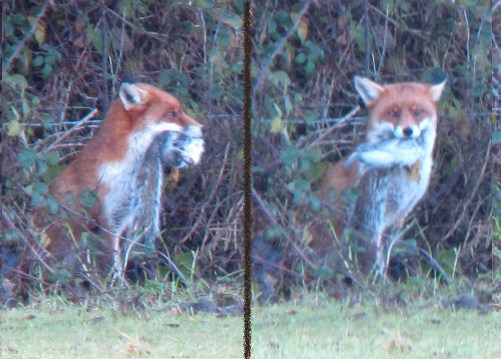
Guillemot
Tony Wootton
got lucky on Hayling Island today with this Guillemot
on the sea.

Guillemot is described
as a scarce winter visitor in the Hampshire Bird
Report with only 18 reported sightings in 2016.
Checking the HOS site, there have been just 3
sightings in the past month, none on Hayling Island. I
have had two sightings in Emsworth Harbour over the
past 10 years or so.
SUNDAY
DECEMBER 17 - 2017
Farlington
Marshes
The Havant
Wildlife Group were on Farlington Marshes yesterday
Dec 16) and got some interesting sightings. They
enjoyed watching a Goldcrest taking a prolonged bath
in a muddy puddle.

Best of all was the
opportunity to compare Rock Pipit and Water Pipit.
Derek Mills managed to get a photo of a Rock Pipit
(left) and a Water Pipit (right), the latter showing
its distinctive white supercilium.
A full report is on
the Havant Wildlife Group web page at . . .
http://familyfellows.com/hwg-walk-reports-2017.htm
FRIDAY
DECEMBER 15 - 2017
Emsworth
Harbour
Peter
Milinets-Raby had a wander around the Emsworth area
this afternoon 1:52pm to 3:36pm - low tide. His report
follows . . .
Beacon Square:
140 Dunlin, 285 Brent Geese, 5 Black-tailed Godwit, 19
Wigeon, 1 male Pintail, Redshank with colour rings
(-//O + O//GW & -//G + G//LW), 1 Grey Plover, 1
Ringed Plover (-//- + G//NB), 1 Turnstone.
Nore Barn: 114 Black-tailed Godwit, 6 male and
20 female Pintail, 52 Wigeon, 25 Teal, 123 Brent
Geese, 7 Shelduck, 71 Dunlin.
Emsworth Harbour: 173 Dunlin, 1 Ringed Plover
(-//- + G//RO), 4 Teal, 8 Black-tailed Godwit, 3
Turnstone, 3 Lapwing, 70 Brent Geese, 20 Shelduck, 7
Grey Plover, 2 Greenshank, 4 Red Breasted Merganser, 2
Little Egret.
Mill Pond: 30 Coot, 1 Cormorant, Juvenile
Goosander flew into the pond at 2:49pm.
Winter
Hedgehogs
Caroline
French and Andrew Brown both responded with some
anxiety to the discovery by Sue Thomas of a small
Hedgehog in her garden (reported in yesterday's blog).
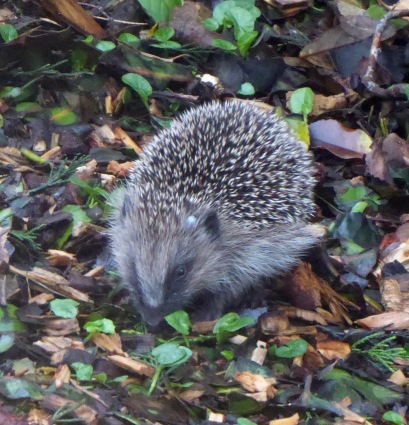
Caroline stressed that
any hedgehog out in the daytime at any time of the
year is in trouble and needs to go to a wildlife
hospital. Also, any hedgehog under 600g is unlikely to
survive the winter. Brent Lodge can help in either
case. Andrew added that a friend of his looked after a
few Hedgehogs last winter that were chronically
underweight for the winter hibernation. Sue can always
call a hedgehog sanctuary for more info if she is
worried or needs advice.
Brent Lodge Wildlife Hospital Sidlesham. Phone 01243
641672.
Barred
Warbler
Tony Wootton
went to Titchfield Haven today to see if he could find
the Barred Warbler, (a rare visitor from Eastern
Europe/Russia). He said it was dead easy, first find
the twitchers and there it was, and very accommodating
bird it was too.
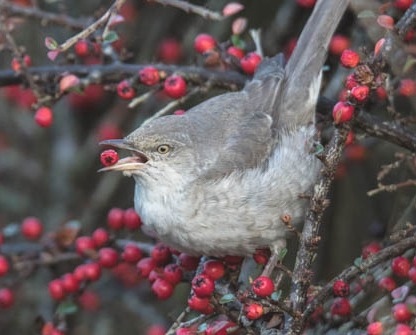
Christopher Evans also
saw the Barred Warbler during a U3A trip to Titchfield
on Dec 7th, so it is clearly settled for a while,
feasting on the red berries.
THURSDAY
DECEMBER 14 - 2017
Nore
Barn
I had a quick
look at Nore Barn at 11am on a falling tide. There was
still plenty of water in the bay and the stream was
fairly full. However, the ever faithful Spotted
Redshank was already feeding along the edge of the
stream with its companion the colour-ringed
Greenshank G+GL. They were both unfazed by the
attentions of boisterous dogs which they have become
used to over the years.
Also feeding in the
stream were several Black-tailed Godwits which
would be moving further out as the tide fell.
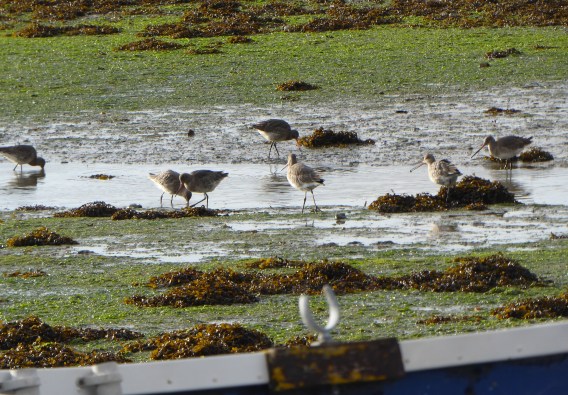
Langstone
Mill Pond
Peter
Milinets-Raby visited Langstone Mill Pond this
afternoon from 1:50pm to 2:42pm - low tide. His report
follows . . .
On my initial scan I
found an adult Peregrine perched on a mound of seaweed
on the far side of the channel ripping the guts out of
a kill. It stayed there having lunch for my entire
visit.
Other birds of note were: 15 Teal, 32 Wigeon, 1 adult
winter Mediterranean Gull, 2 Great Crested Grebe, 16
Grey Plover, 197 Brent Geese, 62 Shelduck, 4
Red-breasted Merganser, 1 Kingfisher dashing along the
channel in the middle, 114 Dunlin, 1 Greenshank (G//R
+ BR//-), 3 Common Gull.
On the pond: 9 Teal, Female Pond Pintail, 1 Kingfisher
(unusually seen perched at the rear of the pond), 1
Grey Heron, 1 Little Grebe.
Flooded Horse paddock (packed with birds): 105 Teal, 4
Black-tailed Godwit, 1 Redshank - very unusual here, 1
Green Sandpiper, 2 Pied Wagtails, 12 Moorhen, 2 Stock
Dove, 3 Little Egret, 1 Grey Heron, 2 Oystercatcher, 1
Curlew, 6 Mallard, 50+ Starling, 2 Song Thrush, 18
Black-headed Gull.
December
Hedgehog
Sue Thomas had
the pleasure of seeing a small hedgehog in her garden.
She says . . .
"It rummaged around the dead leaves and wood chippings
in the borders then had a drink in the bird bath. I
hope it has somewhere warm to spend the rest of the
winter. I noticed a small white 'ball' behind one
ear...I guess that is a tick of some sort?
In the border which is
really woodland and wood chip paths, Lesser Celandine
leaves are coming through - not a sign of spring yet
but a welcome bit of fresh green. These are allowed
wild flowers of course, not weeds!"
Climate
change effect on UK's birds
The latest
State of the UK's Birds Report highlights how many of
the UK's species are already being affected by climate
change, responding to UK average summer temperatures
having increased by nearly 1 degree C since the 1980s.
While some summer migrants are arriving earlier, the
distributions of others are moving northwards and some
species are using the opportunity to colonise new
areas. Milder winters mean that some species, such as
Golden Plover and Dunlin, are benefiting from improved
survival. Birds are showing changes in abundance and
distribution, predominantly moving northwards, in a
way consistent with a changing climate.
See report at . . . http://bto-enews.org/IG4-5BLWV-3RN36S-2XF0M7-0/c.aspx
TUESDAY
DECEMBER 12 - 2017
Emsworth
walk
A very cold
and frosty morning, but no wind and quite pleasant
walking. A number of birds were feeding in the low
water channel beneath the quay, including
colour-ringed Greenshank RG+BY which is a
regular in Emsworth.
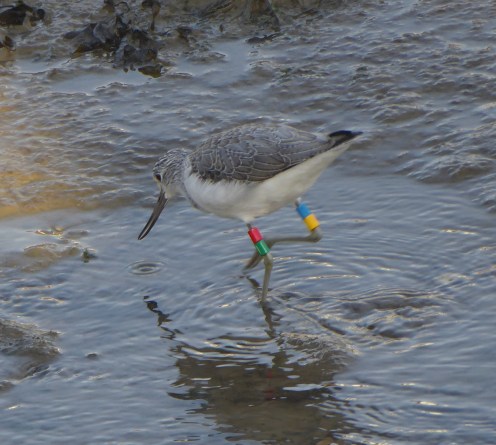
It was one of 3
Greenshanks Pete Potts caught and ringed at Thorney on
19-Mar-13 and fitted with geolocators to the blue
rings. I think the geolocator has now been removed for
analysis as it is not visible now. My last sighting
was 28-Sep-17 and it was also seen by John Jury on
15-Nov-17.
Other birds
feeding in the channel included 2 Dunlin - not often
seen this close to the shore.
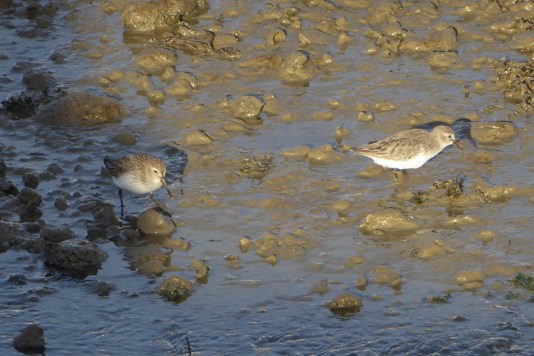
Little Egret and gulls
waiting for fish by the outfall on the north side of
the channel.
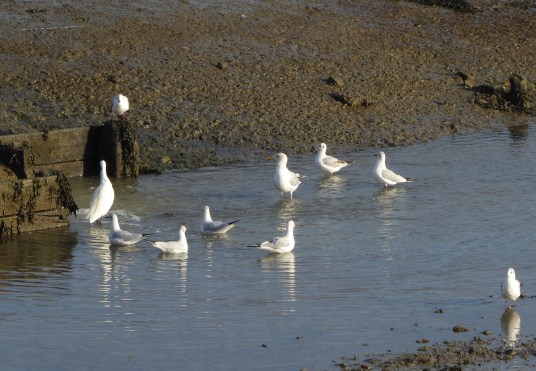
The millponds were largely frozen over, though the
Mute Swan family on Slipper Millpond managed to
find a small area of open water to swan about on.
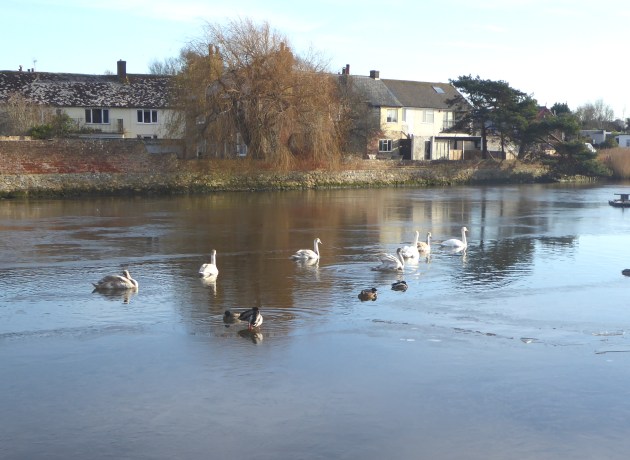
Black-headed Gulls,
including a few Common Gulls, preferred to stand on
the ice

One of the Common
Gulls - a second winter as indicated by the thick band
on its bill and small white primary tips.
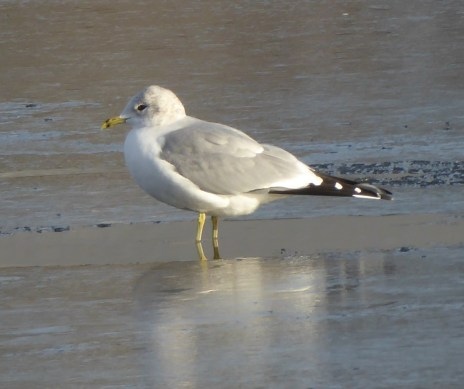
A pair of Herring
Gulls preferred the relative warmth of the south
raft.
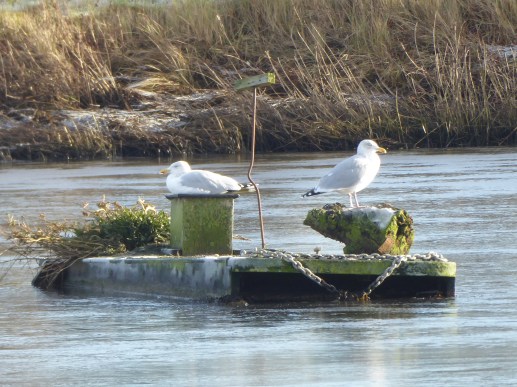
The town millpond was
also frozen over, so no chance of a Goosander.
However, it was nice to see Yarrow plants flowering on
the edge of the millpond by Bath Road, mostly with
white florets, but a few bright pink ones.

Emsworth
Harbour
Peter
Milinets-Raby had a spare 45 minutes this afternoon,
so visited Emsworth Harbour from 1:48pm to 2:45pm -
lowish tide. His report follows . . .
Beacon Square: 6 male and 11 female Pintail, 12
Wigeon, 79 Brent Geese, 4 Teal, 16 Dunlin. 1
Spotted Redshank - feeding in the gully by the
footpath entrance to Beacon Square. Alas, I did not
have time to walk along to Nore Barn to check the
presence of the regular bird, but this is likely to be
the second individual that has been seen once or twice
this winter.
5 Ringed Plover (colour ringed -//- + G//NB), Colour
ringed Redshank (-//O + O//GW), 1 Grey Plover.
Emsworth
Harbour: The female Goosander flew over the
sailing club heading east, diverted over the pond,
obviously saw that it was frozen and continued on
heading east. 12 Teal, 222 Dunlin, 132 Brent Geese, 9
Grey Plover, 9 Turnstone, 23 Coot with 41 on the
Millpond (half frozen), 26 Shelduck, 1 Black-tailed
Godwit.
MONDAY
DECEMBER 11 - 2017
More
Goosanders
Barry Collins
had a walk along the west side of Thorney Deeps on
Saturday morning and had 4 redhead Goosanders on the
Great Deep, one of which took off and flew towards
Emsworth at 10.45. That latter bird might well be the
one that we see from time to time on the town
millpond.
In fact, I might well have seen it on the millpond
yesterday afternoon (Dec 10). Here is my photo of the
bird in rather murky conditions.
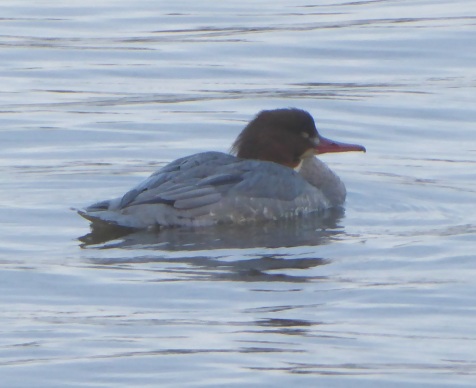
I was also interested
to see six Cormorants on the Slipper Mill
Sailing Club pontoons, no doubt resting after a
fishing session. This probably indicates a plentiful
supply of fish in the pond which would certainly be an
attraction to the Goosander.

Southmoor
flooding plan - an alternative view
So far, the
response to the Environment Agency's plans to flood
the Southmoor at Langstone has been very positive,
particularly in that they will create an extra area of
wetland for wintering geese, ducks and waders.
However, Tom Bickerton presents a slightly different
alternative view of the plans. He writes . . .
"In
principle I like the idea, but we lose, ground nesting
birds, small mammals and a good hunting ground for
kestrel, Short-eared Owl and Barn owl and roosting
areas in the Tamarisk.
Also
do we need yet more saltmarsh? The birds that feed at
Southmoor will still do so, creating a new saltmarsh
just moves them 100 yards north. We need to look
outside the box sometimes when we do these civil
engineering projects and create a lasting legacy. What
does the three harbours lack? Mostly, disturbance free
breeding areas for our terns but more importantly for
our small waders.
What I
would do in the flooded area, while it's easy, would
be to build some tern islands. Built properly and
secured from fox and egg collectors these islands
could be maintenance free for decades. But build them
properly to last without maintenance, make them fox
proof, dig a deep moat around them to flood at low
tide. Oystercatcher and maybe Ringed Plover could use
them.
The RSPB islands in Langstone Harbour are on their
last legs without serious work put in. We got lucky
this year with the Little Terns, but we have to
eliminate this yearly throw of the dice attitude and
get positive gains year on year. The same issue
affects the Oysterbeds, they're never going to improve
them, so again we'll get the first wash-out then the
2nd attempt at breeding.
It
seems to me that the Southmoor plans have one serious
design flaw and that is the attempt to design a human
element into it. There will be a path on the
embankment to the north which inevitably means
increased human usage along with more and more
disturbance.
The
orchid field still worries me. I used to do a WeBS
count at Southmoor for many years, Even well away from
the wall, I occasionally got soaked from sea spray.
Contamination of the field by salt water is, I feel, a
serious risk.
Finally,
I feel the success of the plan will depend on the size
of the breech. If we are creating a break-water, such
as Dover Harbour, then fine, but I feel this project
is more to do with reduced maintenance expenditure
than creating viable habitat. The existing outer wall
will deteriorate over time, thus increasing tidal
flooding activity."
SUNDAY
DECEMBER 10 - 2017
Coal
Tits in gardens
The BTO
reports that winter 2017 is turning out to be
exceptional for garden Coal Tits. In the summer Coal
Tits normally remain within woodland, and are recorded
in less than a third of gardens, but in winter they
move to gardens in search of food. Usually in November
they are recorded by about 40% of Garden BirdWatchers,
but this November they have been seen in an
unprecedented 70% of gardens. It is thought this maybe
due the scarcity of tree seed crops in the wider
countryside.
For more details see . . . http://bto-enews.org/NXK-5AHE5-3UEDCR-2X7EDO-0/c.aspx
I have seen the same
effect here in my garden in central Emsworth. Coal
Tits have always been a rare bird, usually seen only 3
or 4 times in a year in winter and none at all last
year. However, this winter I have had regular visits
from a single Coal Tit almost every week over the past
two months. So far, I have not been quick enough to
capture the bird on camera; the bird hops onto the
sunflower heart feeder, snatches a seed and then flies
away to nibble it in the bushes. However, here is a
nice shot from my files taken by my friend Patrick
Murphy who sadly passed away last year.

SATURDAY
DECEMBER 9 - 2017
Warblington
shore
Peter
Milinets-Raby had a walk along the Warblington shore
from 7:45am to 9:25am - low tide - apparently -3C. It
was cold, but not as icy as it could have been. His
report follows . . .
"Ibis
Field: At the back resting on the dead tree was the
Cattle Egret, with a male Pheasant in the field and 2
Jay over.
Rotting wheat stem pile in the big field: 4 Meadow
Pipits, 2 Pied Wagtails, 1 Grey Wagtail, 2 Skylark.
Conigar Point - a bit quiet?: Reed Bunting calling
from the hedge behind the point, 3 Wigeon, 3 female
Pintail, 10 Teal, 8 Brent Geese, 1 Little Egret, 1
Buzzard chased off the SSSI field by Carrion Crows and
headed south to Hayling Island.
Off Pook Lane: 302 Brent Geese, 44 Teal, 6 Redwing
over and 2 in the hedge along the SSSI field, 4
Lapwing, 3 Red-breasted Merganser, 81 Shelduck - best
count of the winter so far. Will we get into double
figures like last winter? 3 Greenshank.
A Pair of Shoveler flew west along the channel
(possibly the Langstone Pond birds). 8 Little Egrets
feeding in the trickle of water left from the tide
going out. 19 Dunlin, 11 Black-tailed Godwits, 5 Grey
Plover, 4 Bar-tailed Godwit.
3 Redwing in the cemetery (see photo). Very flighty
birds, not settling. Oh, and 1 Blue Tit, 2 Robins and
10+ Blackbirds in the pristine cemetery
habitat!!"

Solar
Boat sightings
John Arnott
had a very good bird watching trip today on Solar
Heritage boat in Chichester Harbour. Chris
Berners-Price was skipper and, as the weather was
ideal, he took the boat further towards the entrance
to the Harbour than usual to increase the chance of
seeing Diver species. Good for you Chris, for they saw
both Black-throated Diver and Great Northern Diver,
plus three Peregrines and a Harbour seal resting on a
mud bank. They also had great views of all the usual
water bird species, including Knot which is not often
seen on these boat trips. Here is John's 'record shot'
of the Black-throated Diver.
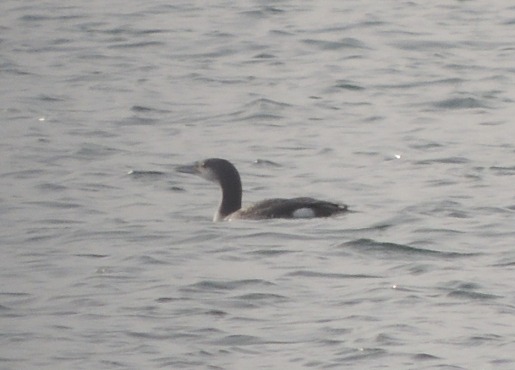
FRIDAY
DECEMBER 8 - 2017
Southmoor
flood plan
Peter
Milinets-Raby is ecstatic about the Environment Agency
plan to flood part of the Southmoor at Langstone.
He says . . . "these
plans will make Southmoor into another Medmerry in
West Sussex, so I will expect breeding Avocets,
Black-winged Stilts and Glossy Ibis within four years
of the work being completed. You heard it here first.
I like the sound of this. It will be a great addition
to improve the pitiful numbers of birdlife in this
eastern corner of Hampshire.
However, my logical mind is asking. Why it is being
done? To stop houses being flooded. What houses -
there are none! And, if the sea levels are expected to
rise, then surely the whole coastline floods. If the
water levels rise to six metres, then it rises to six
metres along the whole stretch of the coast. Making a
breach just allows water to run in more quickly, not
really alleviating the rest of the coastline, which
will flood as the tide washes over the five metre sea
walls. Surely to stop flooding you build the sea wall
up higher to six metres. QED.
I think someone in the bird department is fed up of
the lack of birds seen at Southmoor and likes the idea
of a Hampshire "Medmerry".
Note on
Medmerry
Medmerry is one of the newest of the RSPB nature
reserves near to Bracklesham Bay in West Sussex. It
was created between 2011 - 2013 when the Environment
Agency breached the seawall and flooded the interior
fields, much as is proposed for the Southmoor, but on
a much larger scale. In fact over 4 miles of new flood
bank was constructed inland from the sea before the
existing shingle beach was breached to create the
largest managed realignment scheme on the open coast
in Europe.
It became an RSPB reserve in 2014 and since then the
intertidal habitats have been developing fast,
attracting a wide range of wetland birds. Brent Geese,
Curlew and Grey Plover winter there, whilst in summer
Avocets and Lapwings breed on the lagoons and
saltmarsh.
Ralph Hollins is
cautiously optimistic about the Southmoor plan. He
says . . . "My
reaction is that it is the best that can be done in
the circumstances. I doubt it will have a significant
effect on the orchid population and I fear there are
few ground nesting birds left in the area. I think the
flooding will provide a few years delay in the ongoing
deterioration in the wildlife of the area and many
even bring in some new species (Avocets?? Black-winged
Stilts??)"
I asked orchid expert,
Nigel Johnson if the flooding would affect the growth
of Southern Marsh Orchids on the moor. Nigel thought
as the new bund will be to the south of the orchid
field the orchids should not be unaffected.
Langstone
Mill Pond
Peter
Milinets-Raby had a high tide visit to Langstone Mill
Pond this afternoon 2:45pm to 3:23pm
He said . . . "it
produced an amazing record count of 3 male and 9
female Goldeneye. They were together in the bay by
the entrance to the Pook Lane track. My highest count.
The males were busy displaying to one another whilst
the females ignored them and dived for food.
Other birds of note on the impressive 5 metre tide
(very high - water as far as the eye could see and
only a few centimetres from the top of the sea wall!)
were 12 Red-breasted Mergansers and 2 Great Crested
Grebes. A Kingfisher dashed across the water heading
towards the paddock, in which were 5 Grey Herons, 5
Little Egrets, a Grey Wagtail and 2
Oystercatchers.
On the pond there was nothing of note, except a single
Little Grebe, 36 Mallard and 2 Mute Swans. No Teal and
alas no sign of the male Shoveler. Icy tomorrow -
should be interesting???"
Red
Kites fighting?
Tony Wootton
got a sequence of photos of two Red Kites apparently
fighting at a site close to East Meon Has anyone seen
any example of this before? I have seen Buzzards
fighting over food, but to see Red Kites in action
must be pretty special.

THURSDAY
DECEMBER 7 - 2017
Southmoor
flooding plans
I gather the
Environment Agency is planning to change the sea
defences at Southmoor, Langstone to mitigate the
effects of flooding caused by rising sea levels. The
plan is to breach the present seawall about half way
along the path to allow the sea to flood the moor. A
new earth embankment would be built across the moor,
roughly where the present fence is located, to prevent
to sea flooding any further north. There would be a
footpath on top of the embankment for access across
the moor. The present seawall footpath would be
stopped at the breach. It is thought that as well as
helping to prevent flooding of houses, the plans would
create a new wetland habitat for wildlife inside the
present seawall.
Here is a Environment Agency plan of the area showing
the main features of the new project. The red
annotations are mine just to make the map clearer.
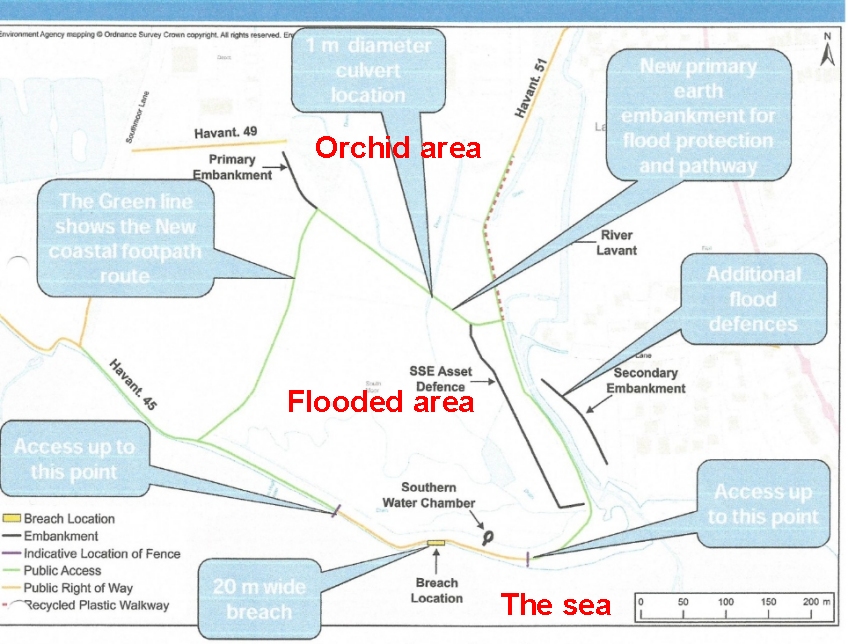
From a wildlife point
of view one can see some advantages in that the new
wetland area could provide extra feeding habitat for
migrant waders, ducks and geese. However, ground
nesting birds in the present area would be affected by
the flooding. More serious is the potential effects
the salt water flooding could have on the botanically
rich fields to the north of the proposed embankment,
where some 10,000 Southern Marsh Orchids flower.
If you have any views about this scheme please let me
know.
Here is a link to the
planning application at HBC https://planningpublicaccess.havant.gov.uk/online-applications/applicationDetails.do?activeTab=documents&keyVal=DCAPR_242378
Barred
Warbler
Christopher
Evans went on a walk in Titchfield Haven reserve today
with the Havant U3A group and got very lucky with this
Barred Warbler. Barred Warbler is described as a 'rare
vagrant' in the current Hampshire Bird Report. There
was only one recorded in 2016 at Sinah Common on
Hayling Island and only five previous records this
century. So Havant U3A were very lucky. What a
Christmas present! Photo courtesy of Doug
Yelland,
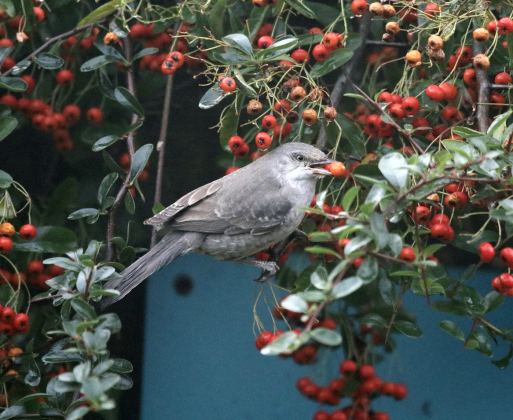
WEDNESDAY
DECEMBER 6 - 2017
Warblington
Hedgerow
Despite the
gloom, Peter Milinets-Raby had a stroll around the
Warblington cemetery area 1:15pm to 2:15pm - High
tide. As it was high tide he concentrated on the
cemetery and the big fields east of the church. His
report follows . . .
"On December 1st the
council had employed Norse to cut the hedgerow along
the northern boundary of the new cemetery extension. I
was shocked to see how drastic it had been cut down!
What was once 4 metres high and at least a metre thick
was butchered to what can be seen in the bright sunny
photo (Ironic - nice views of the castle tower). The
workers on site said that they were not cutting any
more of the hedgerow down.
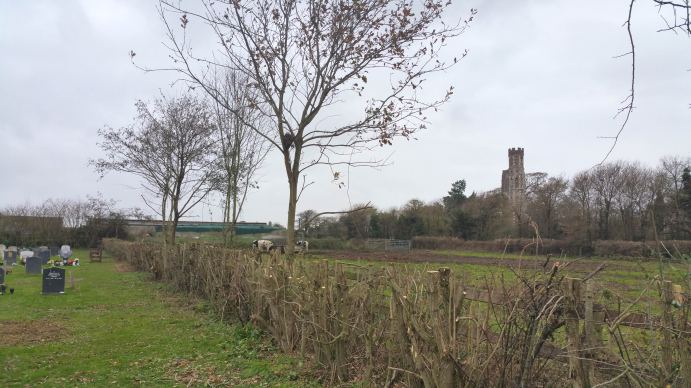
To my astonishment
this afternoon I discovered that the whole length of
the hedge had been felled (the seat in the distance in
the photo is the one in the sunny photo - over 80
metres of hedge gone - good breeding habitat gone,
good winter thrush feeding area gone (Redwing and
Fieldfare seen recently in this hedge). Total shame.
The council just do not know how to look after this so
called conservation area. It has become too clinical
over the last few years, clearing all the good "wild
bits". No wonder I hardly see any passerines when I
walk around this area!

Onto the birds. With
all the disturbance and noise, there were very little
birds to report: In the big field by the rotting wheat
stems: No sign of the Water Pipit, though 2 Pied
Wagtails present with a Grey Wagtail, 3 Skylarks and a
Meadow Pipit.
In the field south of the cemetery: 138 Brent Geese
(contained 2 juvs. Are these the only ones, just
moving around slightly, or are there four birds?). 46
Curlew, 1 Mistle Thrush, 6 Redwing feeding in the
hedge, 1 Green Woodpecker.
In the field west of the cemetery: Briefly (literally
only two minutes worth - before a dog walker flushed
them) were 4 Little Egrets and 1 Cattle Egret. Could
not find them later, obviously flew into the central
fields out of sight!
TUESDAY
DECEMBER 5 - 2017
Goosander
returns
I decided to
have a late afternoon walk (about 3.30pm) around the
millpond, not really expecting to see much, though
fortunately I did take my trusty Lumix TZ70 camera
with me. I was striding in time with Beethoven's 4th
symphony on my bluetooth earphones when a ripple on
the surface of the pond caught my eye. Maybe it was a
Coot, but wait for it to come up. Wow, it was the
juvenile Goosander which I had not seen since Nov 20,
though it was reported to me by Nicola Hammond on 24
Nov. I took some pictures, but the light was awful,
almost dark and this was the best I could manage. This
follows the two redhead (female) Goosanders that Barry
and Margaret Collins saw on the Great Deep west side
on Dec 3, so there are more about.
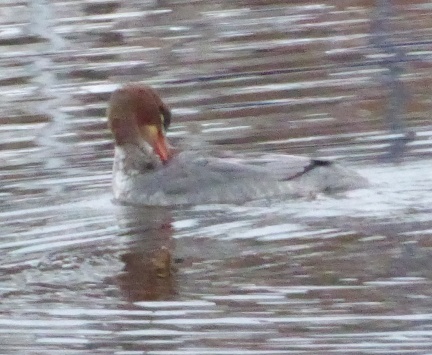
Red-breasted
Mergansers
Interestingly,
Susan Kelly saw 4 Red-breasted Mergansers in the
harbour this morning near the Slipper Sailing Club. If
they also come onto the millpond it could make for a
nice comparison with the Goosander. Here is a cracking
shot that Richard Somerscocks got of some male
Red-breasted Mergansers displaying to females in
Emsworth Harbour a few years ago.

WW2
aircraft collision over Brook Meadow
Here is a link
to some memories by Adrian Voller of the collision
between a Wellington bomber and a Mosquito
Nightfighter over Emsworth in 1944 which claimed two
airmen's lives . This WW2 incident is commemorated in
a plaque on the north bridge on Brook Meadow.
Here is the link to
the story . . . http://www.bbc.co.uk/history/ww2peopleswar/stories/22/a1138222.shtml
MONDAY
DECEMBER 4 - 2017
Emsworth
walk
I had a stroll
around the local area before an early lunch. I stopped
to admire the nice contrast between the red Hawthorn
berries and the green Mistletoe on the tree in Bridge
Road car park.

Walking down Bath Road
I was pleasantly surprised to find a group of workers
from Norse clearing the weeds from the edge of the
roadside by hand! I congratulated them for not using a
spray which has been the custom in the past. Let's
hope HBC (Norse) has abandoned this awful unecological
practice which contaminates the environment and leaves
ugly burnt scars. The three Norse workers were happy
for me to take a photo of them at work.
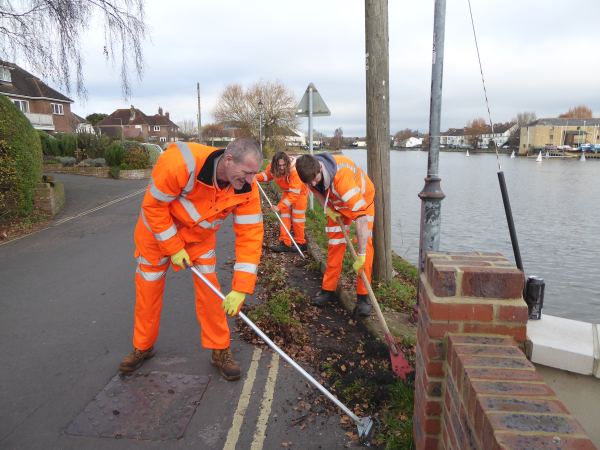
Two Cormorants were
fishing on the Millpond but no sign of the Goosander -
but see Barry's note below. No sign either of the
Black Swans that were in the harbour yesterday.
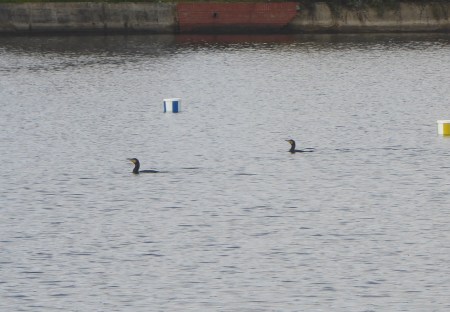
I came back home via
Brook Meadow where I stopped to admire the neatly
trimmed Hawthorn laid hedge and the newly woven dead
hedge on the river bank from yesterday's work session.
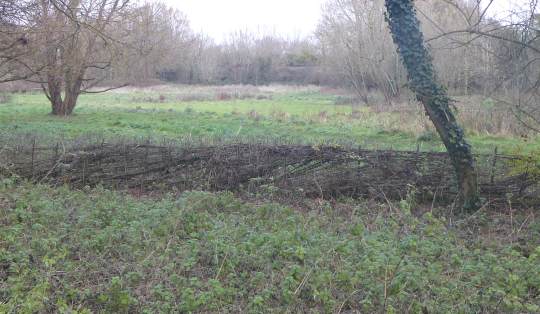
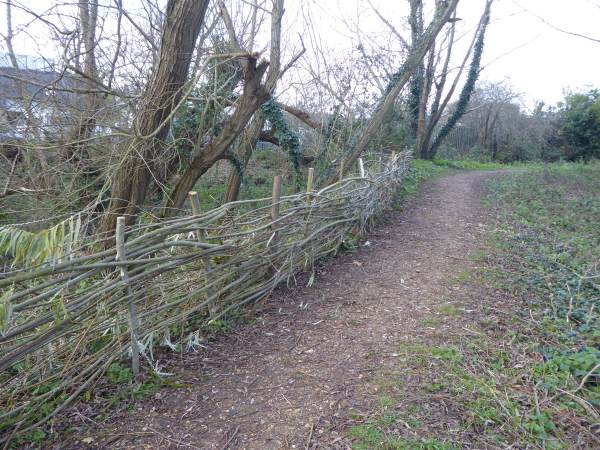
Goosanders
on Thorney
Barry and
Margaret Collins had two redhead Goosanders on the
Great Deep west side yesterday (Dec 3) and a juvenile
Marsh Harrier foraging over the Little Deeps.
Langstone
Mill Pond
This afternoon
Peter Milinets-Raby visited Langstone Mill Pond at
1:38pm and watched the tide drop until 3:15pm. As it
did so, the birds moved in . . .
59 Shelduck, 200+ Brent Geese, 8 Red-breasted
Merganser, Male Goldeneye, 19 Wigeon, 5 Grey Plover,
49 Teal, 22 Dunlin, 1 Greenshank (G//R + BR//-), 1
Kingfisher - very mobile. One minute on a boat out in
the harbour, the next dashing over the pond. 5 Little
Egrets, 8 Common Gull. 11 Black-tailed Godwit (R//R +
LG//- see photo - though in one photo it looks
white???),
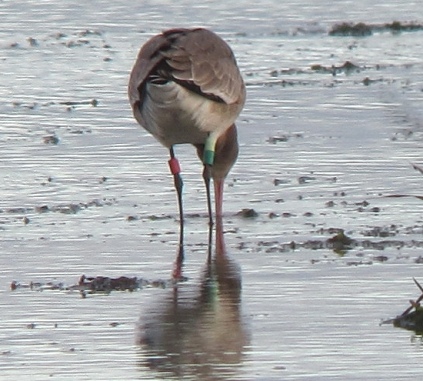
On the Pond: Nothing
when I arrived, just the lingering male Shoveler (see
photo), which after ten minutes flew out into the
channel to feed. When I left, the pond held 34 Teal, 2
Little Grebes and the female pond Pintail. Most of the
Teal (34 on the pond and the 49 on the mud) were
observed flying in from Thorney Island.
Of interest were a pair of Grey Heron on the big
obvious nest, moving sticks around and attempting to
mate.
Brian's note on
colour-ringed Black-tailed Godwit R+LG - First
seen at Nore Barn on 23-Oct-13 and seen each early
winter since then. It seems to be a Langstone - Nore
Barn bird. I have never seen it on the east side of
Emsworth.
SUNDAY
DECEMBER 3 - 2017
Brook
Meadow work session
It was a
relatively mild morning compared with recent ones for
the regular first Sunday in the month work session on
Brook Meadow. There was a good turn out of 11
volunteers led by Mike. The main tasks were to
reconstruct the dead hedges along the river bank and
to trim and tidy Mike's laid Hawthorn hedge.
Here is Mike
discussing the hedge trimming with one of the
volunteers
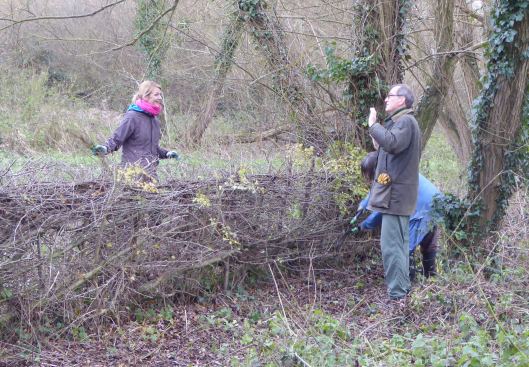
For the full report
and more photos see . . . https://www.brookmeadow.org.uk/conservation-news/
Black
Swans return
We have had a
single Black Swan in the Emsworth area for the past
week or so, but this morning Chris Oakley alerted me
to the presence of three of them in Emsworth Harbour.
So this afternoon I went down to take a look for
myself and, true to form, three Black Swans were in
the low water channel at the end of the wooden jetty.
Here they are
with one showing off its white underwings
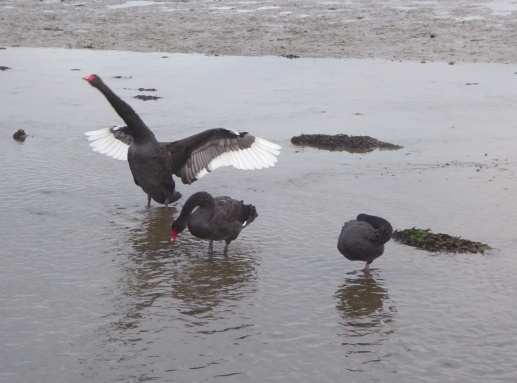
They may well be part
of the family of six which were in Emsworth Harbour
from Jan 27 until Mar 11 earlier this year. These
birds came from a nest site at Riverside Park on the
River Itchen in Southampton. It will be interesting to
see if any more turn up.
Warblington
shore
Peter
Milinets-Raby visited the Warblington shore this
morning from 7:36am to 9:30am - nearly high tide.
Warblington cemetery: 17 Redwing, 1 Jay, 1 Meadow
Pipit over.
Ibis Field: 1 male and 3 female Pheasant.
Big field with rotting wheat stem pile: 4 Pied
Wagtail, 1 Grey Wagtail, 1 Water Pipit feeding amongst
the pile - worth checking this area again as this bird
may hang around. 2 Meadow Pipit over, 2 Skylark.
Water Rail heard squealing from mini reed bed behind
Conigar Point
Conigar Point: 1 Greenshank, 145 Wigeon (good
numbers), 17 Shelduck, 7 male and 16 female Pintail
(good numbers), 233 Dunlin, 11 Grey Plover, 31 Teal, 3
Bar-tailed Godwit. 41 Curlew and 2 Brent Geese in the
field south of the cemetery.
Little Egret
obligingly feeding close in the stream until "Maizie"
the dog flushed him!!!
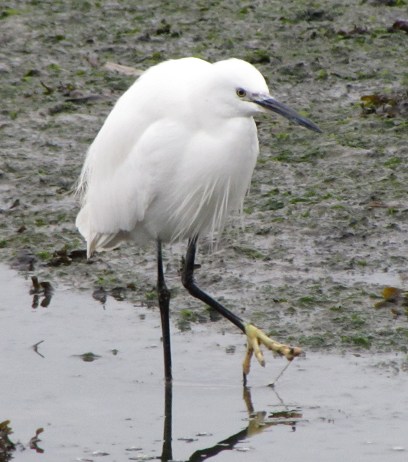
Off Pook Lane - tide
nearly in: 1 Kestrel, 45 Wigeon, 3 Teal, 48 Brent
Geese, 8 Red-breasted Merganser, 9 Lapwing, 2 Grey
Plover, 21 Shelduck, Shoveler male on the shore.
Nore
Barn
In the
afternoon, Peter took the family for a walk along the
shore of Nore Barn and around the corner to the real
Conigar Point - 1:38pm to 2:45pm - tide dropping.
Spotted Redshank in the stream with a Redshank. 2
female Pintail, 233 Brent Geese, 33 Teal, 1 Greenshank
at the top end stream (G//R +GL//-), 173 Wigeon - very
good count, 6 Black-tailed Godwit with a further 127
around the corner (G//R +GY//-)
SATURDAY
DECEMBER 2 - 2017
Black-throated
Diver
John Arnott
saw a Black-throated Diver from the Ellanore bird hide
(West Wittering) this afternoon at 15:06h . . .
"It was in the main
channel opposite the entrance to Snowhill Creek, too
far to photograph but easily 'scoped. At first it was
facing away from me but was looking over its shoulder
showing a peaked crown. My initial thought was Great
Northern Diver but then it turned sideways and showed
a text-book white half moon patch on its rear flanks.
I examined it for the collar of a Great Northern Diver
low on the neck but it was clean white all the way
down the front and very black down the back of the
neck. Typically, the top of the neck gave the
impression of being thicker than the lower half of the
neck and it was very full chested. It then vanished
but I later saw it briefly as it headed for the west
side of East Head and then I finally lost it to view
behind the dunes of the Head.
Lots of other water birds from the hide - Dunlin,
Knot, Bar- and Black-tailed Godwits (this is a good
spot to compare Godwit species), Redshank, Grey
Plover, Oystercatcher, Curlew, Great Crested Grebe,
Cormorant, Shelduck, Red-breasted Merganser and lots
of Black-headed Gull.
Sorry no numbers but my wife went home with the
notebook from our WeBS count at Bosham in the morning
- that was my fault! Pretty quiet on our Bosham sector
count but there was a Whimbrel, first heard then seen
at the entrance to Furzefield Creek on the north side,
sitting on a post of an old fence that runs down the
shore to the waterline.
The Black-throated
Diver was also seen by Bernie Forbes during an outing
to East Head - reported on the SOS Sightings site . .
. https://www.sos.org.uk/recent-sightings
FRIDAY
DECEMBER 1 - 2017
Nore
Barn
12 noon. Tide
falling from high water at about 9am. The sun was low
and very bright making conditions difficult for
viewing and photography. However, at Nore Barn it is
possible to shelter from the north wind. The area
around the stream was crowded with birds, mostly Brent
Geese, Wigeon and Black-tailed Godwits. Here is just a
small section.
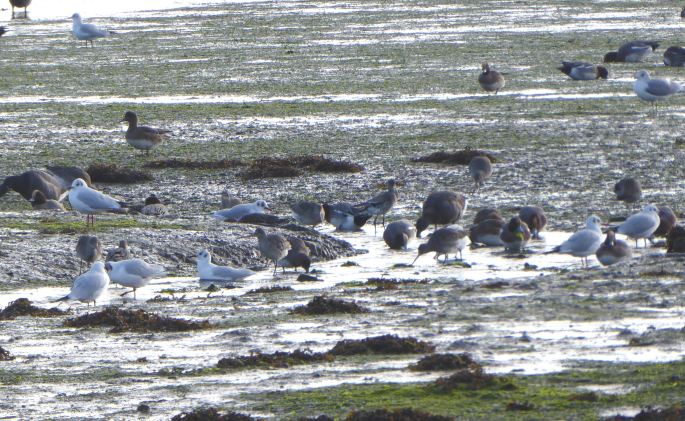
The Spotted
Redshank was also present feeding among the
Godwits. In this photo it is with a Godwit which
appears to be having a little bathe in the fresh
stream water.
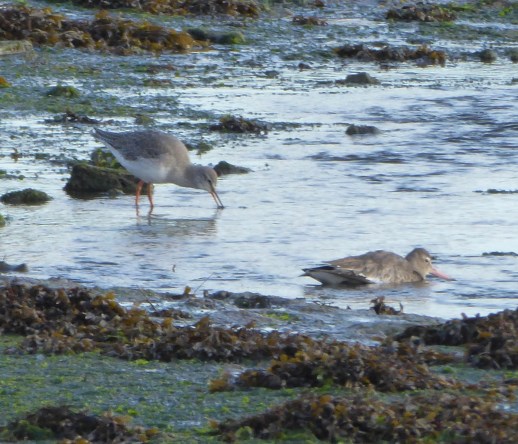
Over 300 Brent Geese
were scattered around the western mudflats including
at least one juvenile - probably from the sole family
of two youngsters. I found two Shelduck among the
Brent Geese. I counted 174 Black-tailed Godwits,
though there could well have been more. This is my
best count of the winter so far. I picked out two
Godwits with colour-rings, G+WR and ROL+RLR - both
mega regular birds in Emsworth Harbour each with over
100 sightings.
Winter
flowers
Quite a number of plants continue to flower right into
winter, so I though I would include a regular spot on
the blog for the ones I notice as I go around town. To
start the ball rolling, here is a not terribly good
snap of some Lesser Stitchwort that has been flowering
for a few weeks by the Beech hedge adjacent to Bridge
Road car park quite close to where I live. It would
not keep still in the wind, but the white sharply
divided petals are very distinctive. It is a perennial
plant and I see it in this spot every year, though
this year it is flowering later than usual.
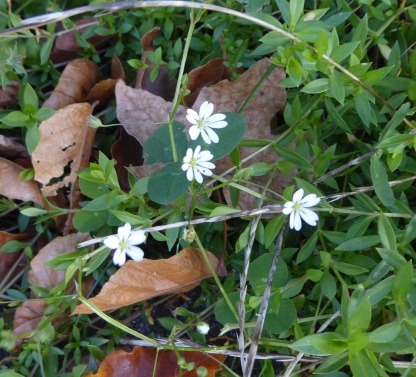
Weasel
on Brook Meadow
Whilst on a
recce (for Sunday's work session) around Brook Meadow,
Mike Probert was fortunate enough to see a Weasel (no
black tip on tail) run across the River Ems from east
to west on a thick, fallen tree trunk - the first one
south of the North bridge. That is the first Weasel we
have had reported on Brook Meadow since one seen and
photographed by Malcolm Phillips on 09-Apr-2014. I
suspect they are more common than this but elusive and
not easily seen. Here is Malcolm's excellent image. We
do miss him - Malcolm that is!
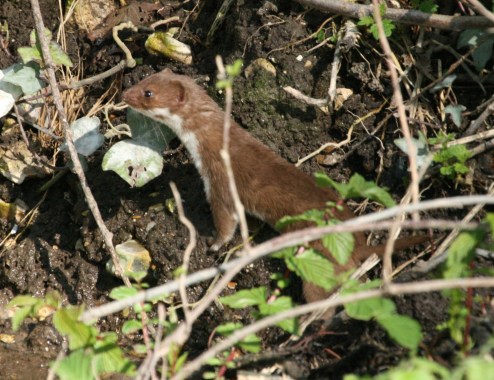
Garden
Sparrowhawk
Keith Wileman
just caught this magnificent female Sparrowhawk on his
garden fence this afternoon a couple of seconds before
it flew away. Wow! What a bird!

Emsworth
Harbour
Peter
Milinets-Raby had a couple of outings today in the
bitter north wind.
The first was from Nore Barn to Emsworth for only 40
minutes from 9am - "just too cold!"
Nore Barn at high tide: 1 Greenshank, 1 Spotted
Redshank and 1 Redshank resting by the stream. 234
Brent Geese, 73 Wigeon, 12 Teal.
Beacon Square: 44 Wigeon, 153 Brent Geese, 8
Shelduck.
Emsworth Harbour: 1 Sandwich Tern, 10 lapwing on the
pier by the town wall.
On the Mill Pond were 3 Cormorants and 39
Coot.
Langstone
Mill Pond
Peter visited
Langstone Mill Pond in the early afternoon (1:11pm to
2:46pm - very low tide):
Off Shore: 6 Red Breasted Merganser, 2 Great Crested
Grebes, 114 Teal, 17 Black-tailed Godwit, 62 Shelduck,
6 Lapwing, 2 Greenshank, 366 Brent Geese (with 2
juvs), 9 Wigeon, 12 Grey Plover, 2 Grey Herons with 9
Little Egrets in the trickle of water in the channel,
100+ Dunlin.
On the pond were: 51 Teal, Male Shoveler, Female
Pintail, 1 Chiffchaff.
1 Little Grebe with fish - Giving stunning views -
Help needed on the ID of the fish - The bird caught
three of these fish - all were this huge size -
reddish tinge in the fins. Amazing sight as it
swallowed them head first.
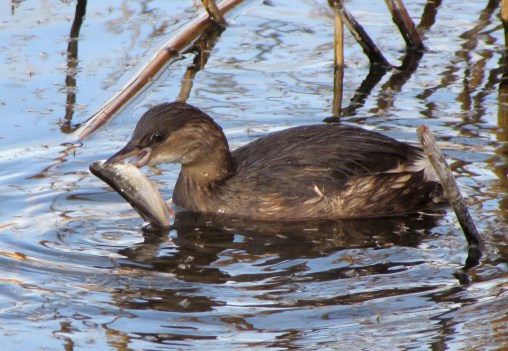
For
the previous month go to . . November
1-30